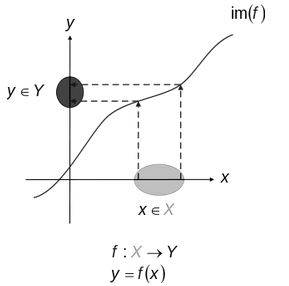
- What is One-to-one Function?
- Weightage of one-to-one functions in Class 12
- Illustrative examples on One-to-one Function
- FAQs on one-to-one functions
What is One-to-one Function?
Functions are extremely significant in mathematics. Thus, it is essential to understand the basics of a function before forging ahead with a one-to-one function. The function states that for every x there is a y. It arises when one element from one set is dependent on exactly one element from another set.
You must understand the one-to-one function to understand any form of equation surrounding the concept of the inverse function and its characteristics. In case of the 1-1 function, here is only one x can be combined with a given y.
What is a One-one Function?
A function is considered a one-to-one function if no two different elements in one set have the same element in another set. The function f(x) can be a one-to-one function only if each element in its spectrum is returned from its domain by a single element. This implies there would be a special value of y for any value of x.
Here, in this example, you can see that the function f(x) is a 1-1 function as every element from one set has a unique element in another set unlike g(x) where two elements from one set have a common function in another set. Therefore, the function g(x) is not a one-one function.
Graph of a One-one Function
The graph of 1-1 function is required to comprehend the concept of one-one function fully. There is a special value of y for any value of x. Therefore, each x is expected to have a unique value for y in a one-one function. No pairs of elements in the x-axis will share coordinates with another element in the y-axis. The graph below will deliver better insights regarding the concept of one-one function.
The above graph accounts for a one-one function where two elements on the x-coordinate are having two distinct elements in the y-coordinate without any sharing taking place among them.
Weightage of one-to-one functions in Class 12
The topic of one-to-one functions is from the chapter relations and functions. The chapter includes various other topics such as types of relations. The chapter has a weightage of eight marks in the 12th final examination.
Illustrative examples on One-to-one Function
1. Show that f is one – one for the following set, Let C = {1, 2, 3} D, = {4, 5, 6, 7} and let f = {(1, 4), (2, 5), (3, 6)} be a function from C to D.
Solution.
f: C → D can be shown as f = {(1, 4), (2, 5), (3, 6)}
We can figure out that each element of A under is unique. Thus, function f is one-one.
2. Show how f is one-one onto where f: R → R can be expressed as f(x) = 3x.
Solution.
Given, R → R can be expressed as f(x) = 3x
Let us consider x and y as the element of R
Therefore, f(x) = f(y)
3x = 3y
x = y, f is one-one.
We can also consider y/3 in R for any real number (y) in the co-domain R. Therefore, f is onto.
3. Show how f is one – one onto where f: R → R can be expressed as f(x) = 2x+1.
Solution.
Given, R → R can be expressed as f(x) = 2x+1
Let us consider x and y as the element of R
Therefore, f(x) = f(y)
2x+1 = 2y+1
x = y, f is one-one.
We can also consider y/3 in R for any real number (y) in the co-domain R. Therefore, f is onto.
FAQs on one-to-one functions
Q: Which graph depicts a one-one function?
Q: What is not considered to be a one-one function?
Q: What is the other name of a one-one function?
Q: Can we consider parabola as a one-one function?
Q: Give some viable examples of one to one function.
Maths Relations and Functions Exam
Student Forum
Other Topics under this Chapter
Other Class 11th Maths Chapters
Popular Courses After 12th
Exams accepted
CA FoundationExams accepted
ICSI ExamExams accepted
BHU UET | GLAET | GD Goenka TestBachelor of Business Administration & Bachelor of Law
Exams accepted
CLAT | LSAT India | AIBEExams accepted
IPMAT | NMIMS - NPAT | SET
Exams accepted
BHU UET | KUK Entrance Exam | JMI Entrance ExamBachelor of Design in Animation (BDes)
Exams accepted
UCEED | NIFT Entrance Exam | NID Entrance ExamBA LLB (Bachelor of Arts + Bachelor of Laws)
Exams accepted
CLAT | AILET | LSAT IndiaBachelor of Journalism & Mass Communication (BJMC)
Exams accepted
LUACMAT | SRMHCAT | GD Goenka Test


